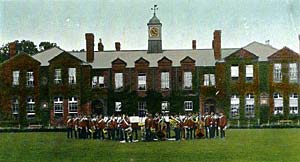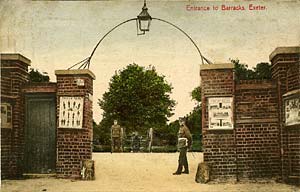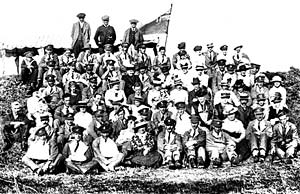
The Higher Barracks, or Cavalry Barracks - Howell Road
Page updated 8 December 2008
The French Revolution disturbed the British Government enough to fear that France could well invade Britain. Nationally, measures were taken to enlarge the armed forces - the Higher Barracks in St David's and the artillery barracks on the Topsham Road were a direct response to this perceived threat in Exeter.
The historian Jenkins wrote of the barracks in 1805:
"A plan having been adopted by the legislature for erecting Barracks in the different parts of this kingdom, two large fields were purchased for that purpose near the new Gaol, in the parish of St. David; and the building was soon after began, and in a few years completed. It is an elegant quadrangle, began to be situated on an eminence, commanding an extensive and beautiful view of the surrounding country: at the upper end are apartments for the officers, and in the two wings are stabling for two hundred and two horses, over which are lodging-rooms for the privates. There is also a riding-school, hospital, farrier's shop, suttling- house (canteen), guard-house, powder magazine, granaries, and every other conveniency that could be adopted for the ease and comfort of the stationed troops."
Higher Barracks were built in 1794 for the cavalry. Designed for 15 officers, 180 men and 202 horses, the barracks covered an area stretching from Red Lane or Howell's Lane in the south to the edge of the Hoopern valley in the north. The site was surrounded by a high brick wall. Towards the rear of the barracks was the Officers’ Quarters Building, a Georgian style, symmetrically-designed building with a grand central doorway and pediment, and topped with the Royal Arms of England. Along each side there were facing barracks. In the centre was a green for parades and exercising horses. The officers' quarters and one barrack block were destroyed in a fire in the 19th Century.
James Cossins remembered in 1870 the barracks when he was a youth:
"At this time we had a succession of cavalry regiments stationed at the barracks, whose bands played for two hours in front of the officers' quarters on Sunday evenings, which attracted a large concourse of people. The barracks are in the parish of St. David. During the incumbency of now the Rev. Chancellor Harington, he held service at nine o'clock on Sunday mornings in the Riding School, many citizens attending. Alluding to soldiers, during the assizes no military men were allowed in the streets wearing uniform; they were either confined within the Barrack yard, or separate troops were sent to the surrounding towns, such as Tiverton, Cullompton, Honiton, &c."
In 1907 Britain was going through a peaceful phase and the need for a large army decreased, so the Government decided to cut back on some military facilities. To this end, plans were made for the housing on the west side of Thornton Hill to be extended into the barracks. Housing was built down three new cul-de-sacs, Hillcross Road, Hillside Avenue and Waverley Avenue, but stopped at the wall, before army land was used.
The barracks were used as a military hospital during the First World War while during the Second World War, many a young conscript started their service life there. The United States 500th Medical Collecting Company (60th Medical Battalion) stayed at the Higher Barracks in January 1944 in preparation for D-Day. In 1987 the Royal Army Pay Corp moved from Taunton to the Higher Barracks, and remained until the barracks were closed prior to their redevelopment by Barratt's in the late 1990's for residential accommodation, to be named Horseguards.
Mr Aggett recalled for People Talking the following memory about Higher Barracks:
"Then of course on Sunday mornings another delightful feature: you could hear the Devonshire Regiment battalion when they were in the barracks; you could hear them playing their regimental marching song, "Over the Fields and Turnips". I think it's one of the finest marching songs in the British Army- it's very cheerful, you know. That was the Higher Barracks at Howell Road; a busy barracks in those days, that sort of leant some character to Exeter: all the soldiers going up and down. They used to march to the Cathedral for their Sunday morning Church Parade, come back to the barracks and they'd give a concert in the centre of the parade ground and the people, the public at large, were allowed to come into the barracks. And it was the custom then to promenade around, like at Hyde Park; the women with their parasols and their Sunday dresses and the fellas just slowly walking around, while these chaps were playing their military music. And of course if you were lucky and knew someone you were invited into the officers' mess and you had a drink. I was invited on two or three occasions. It was all very nice, something's that's gone really."
Source: Various sources including Jenkin's
The Comprehensive History of Exeter.
© 2005 David Cornforth - not to be used without permission
 The band assembles in front of the main building.
The band assembles in front of the main building.
 The entrance to Higher
Barracks.
The entrance to Higher
Barracks.
 Wounded
soldiers at Higher Barracks, 1917. Photo courtesy of Witheridge Historical Archive
Wounded
soldiers at Higher Barracks, 1917. Photo courtesy of Witheridge Historical Archive
│ Top of Page │